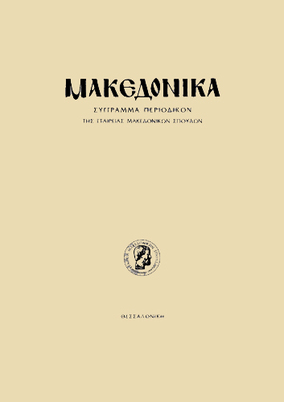Κτερίσματα ελληνιστικού τάφου στη Νεάπολη της Θεσσαλονίκης
Part of : Μακεδονικά ; Vol.25, 1986, pages 180-202
Issue:
Pages:
180-202
Parallel Title:
Burial objects of a hellenistic grave in Neapolis-Thessaloniki.
Section Title:
Articles
Abstract:
In 1958 a chest-shaped grave has been dug out in Neapolis Thessaloniki containing very important burial objects. Their importance lies in their quantity as well as quality and variety. It contained specifically: fourteen terracotta figurines, most of them in perfect condition, twelve gold trinkets, some small objects, three scent-jars, a black-figure vase, and two vases which, as has been proved, must have been manufactured outside of Greece. The first is a skyphos made of moulded glass and the second a corb of porcelain, originating probably from Egypt, which during the reign of the Ptolemaei had developed into an important artistic centre of the hellenistic period.It is worth mentioning about the figurines, that their characteristics, differentiate them from other up to date known groups of figurines in Thessaloniki and the larger Macedonian area. This enables us to assume that their origin may be from a different workshop with highly qualitative standards. The study of the grave’s pottery gave us clear indications and we can place i tin the first half of the 2nd cent. B.C. We came to the same conclusion through the study of the two foreign vases and the artistic characteristics of the figurines.During this particularly politically and financially difficult period, there are rare examples of such rich—in burial objects—graves in Thessaloniki and Macedonia. We deduce therefore, that the dead belonged to a rich family of landowners. One could further assume that the dead was a woman, who died at an early age, as the dolls accompanying her, point out. It is of interest, that some of the objects show a thematic unity (fiom the cycle of Venus and Dionysos) and the selection of certain types of th?m, shows the intention to give the grave a symbolic meaning.Finally it should be noted, that because of the difficulty to place chronologically—at least until now—trinkets, porcelain and glass obj ects, there arevery few that could safely be placed chronologically. The objects of the Neapoli grave, which have been placed in the first half of the 2nd cent. B.C., give us an important reference for dating similar works.
Subject:
Subject (LC):
Notes:
856:https://ejournals.epublishing.ekt.gr/index.php/makedonika/article/view/5788, DOI: https://doi.org/10.12681/makedonika.227
Electronic Resources:




